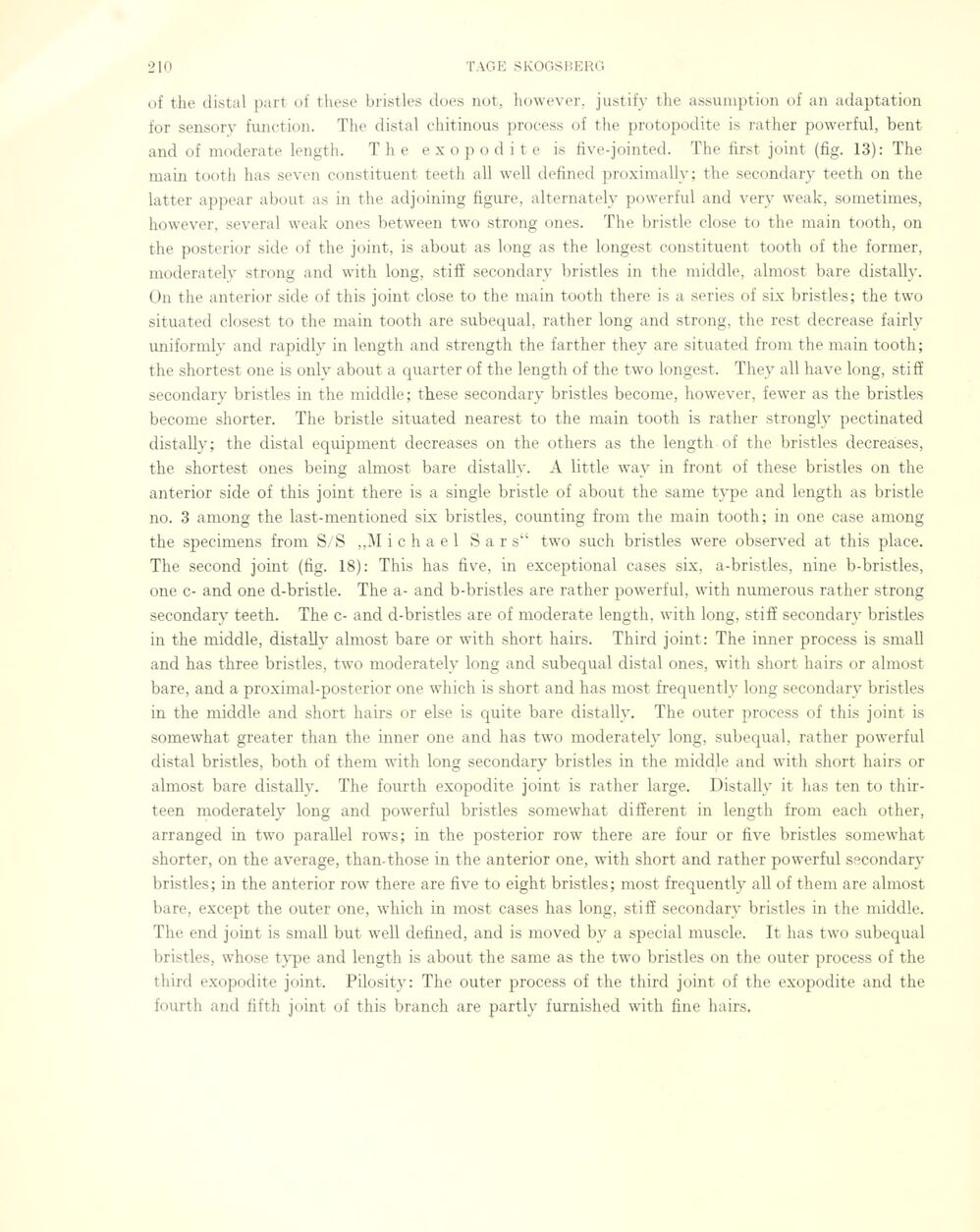
Full resolution (JPEG) - On this page / på denna sida - Sidor ...

<< prev. page << föreg. sida << >> nästa sida >> next page >>
Below is the raw OCR text
from the above scanned image.
Do you see an error? Proofread the page now!
Här nedan syns maskintolkade texten från faksimilbilden ovan.
Ser du något fel? Korrekturläs sidan nu!
This page has never been proofread. / Denna sida har aldrig korrekturlästs.
of the distal part of these bristles does not, however, justify the assumption of an adaptation
for sensory function. The distal chitinous process of the protopodite is rather powerful, bent
and of moderate length. The exopodite is five-jointed. The first joint (fig. 13): The
main tooth has seven constituent teeth all well defined proximally; the secondary teeth on the
latter appear about as in the adjoining figure, alternately powerful and very weak, sometimes,
however, several weak ones between two strong ones. The bristle close to the main tooth, on
the posterior side of the joint, is about as long as the longest constituent tooth of the former,
moderately strong and with long, stifî secondary bristles in the middle, almost bare distally.
On the anterior side of this joint close to the main tooth there is a series of six bristles; the two
situated closest to the main tooth are subequal, rather long and strong, the rest decrease fairly
uniformly and rapidlv in length and strength the farther they are situated from the main tooth;
the shortest one is only about a quarter of the length of the two longest. They all have long, sti ff
secondary bristles in the middle; these secondary bristles become, however, fewer as the bristles
become shorter. The bristle situated nearest to the main tooth is rather strongly pectinated
distally; the distal equipment decreases on the others as the length of the bristles decreases,
the shortest ones being almost bare distally. A little way in front of these bristles on the
anterior side of this joint there is a single bristle of about the same type and length as bristle
no. 3 arnong the last-mentioned six bristles, counting from the main tooth; in one case among
the speeimens from S/S „M i c h a e 1 Sars“ two such bristles were observed at this place.
The second joint (fig. 18): This has five, in exceptional cases six, a-bristles, nine b-bristles,
one c- and one d-bristle. The a- and b-bristles are rather powerful, with numerous rather strong
secondary teeth. The c- and d-bristles are of moderate length, with long, st-iff secondary bristles
in the middle, distally almost bare or with short hairs. Third joint: The inner process is small
and has three bristles, two moderately long and subequal distal ones, with short hairs or almost
bare, and a proximal-posterior one which is short and has most frequently long secondary bristles
in the middle and short hairs or else is quite bare distally. The outer process of this joint is
somewhat greater than the inner one and has two moderately long, subequal, rather powerful
distal bristles, both of them with long secondary bristles in the middle and with short hairs or
almost bare distally. The fourth exopodite joint is rather large. Distally it has ten to
thir-teen moderately long and powerful bristles somewhat different in length from each other,
arranged in two parallel rows; in the posterior row there are four or five bristles somewhat
shorter, on the average, than-those in the anterior one, with short and rather powerful secondary
bristles ; in the anterior row there are five to eight bristles ; most frequently all of them are almost
bare, except the outer one, which in most cases has long, stiff secondary bristles in the middle.
The end joint is small but well defined, and is moved by a special muscle. It has two subequal
bristles, whose type and length is about the same as the two bristles on the outer process of the
third exopodite joint. Pilosity: The outer process of the third joint of the exopodite and the
fourth and fifth joint of this brauch are partly furnished with fine hairs.
<< prev. page << föreg. sida << >> nästa sida >> next page >>